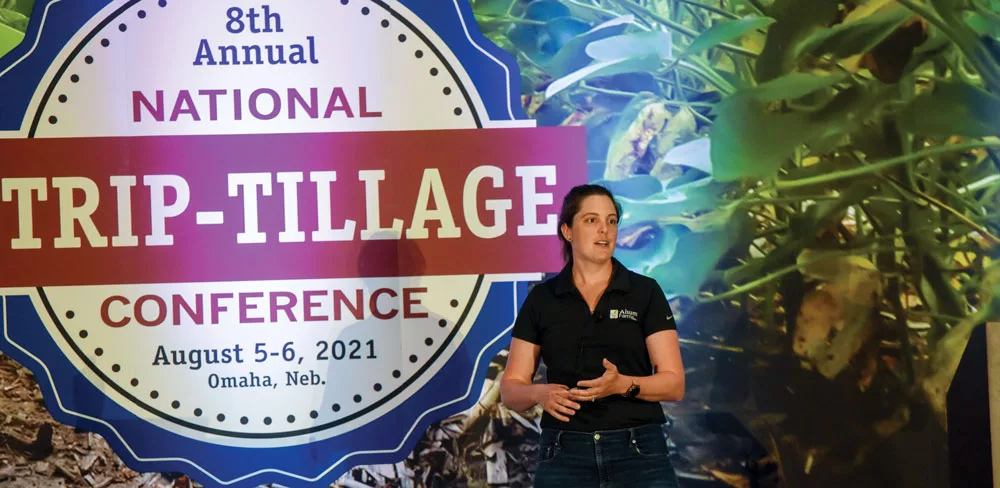I may be a farmer now, but before I came back to the farm, I was in medical school and doing medical research, so doing on-farm experiments is second nature. Typically, experimentation involves writing down your purpose, your experimental procedures and your observations. I remember this being annoying back in school, but as a farmer, it’s an exciting and helpful way to dial in management practices.
I farm with my husband, Eric, a third-generation grower in Grand Marsh, Wis. Our 3,600-acre family farm, Wallendal Farms, was incorporated into Alsum Farms in 2020. Alsum Farms’ 2,700 acres of potatoes and 320 acres of jack o’ lantern pumpkins is a good complement to the 15-20 vegetable processing crops, pumpkins, grains, dry edible beans and organics we’d been growing up to that point.
Alsum Farms is located in the central sands of Wisconsin, and as the name suggests, the soils are very sandy. We’re 100% irrigated and our soil organic matter is very low — usually 1% or less. So strip-till is a good solution for us and we’ve used the practice on the farm since 2012, strip-tilling pumpkins, seed pumpkins, winter squash, cabbage, watermelon, forage corn, seed corn, sweet corn, soybeans, snap beans, dry edible beans and sunflowers over the years.
Roller-Crimped Rye System
One of our most successful experiments has been with pumpkins. In 2015, when we decided to try this crop, it was a bare-ground, conventional tillage field on 44-inch rows because we have a 22-inch planter. It was very weedy and the weeds really affect pumpkin quality — they don’t grow large, they’re sort of misshapen and they’re not higher marketed.
We figured there had to be a better way and decided to try planting them into roller-crimped rye, something we had started experimenting with not long before. Here’s how we refined our system over the course of a couple of seasons.
For our first attempt, in the fall of 2016 we seeded cereal rye. The next spring, we mowed part of the field and roller-crimped the rest. We started strip-tilling when the rye was 6 inches tall. We did a second strip-till pass when the rye was about knee-high. Next, we roller-crimped the rye when it hit anthesis, and then we strip-tilled one last time right before planting. In that last strip-till pass, we applied a 4- and an 8-inch band of nutrients and fertilizer — zinc and a starter.
The mowed section worked OK; the roller-crimped portion worked better. So we decided we’d stick with the roller-crimped system.
Before planting the rye in the fall of 2017, we decided to try cutting back the number of strip-till passes for the 2018 crop, and decided to do two instead of three. So that fall we seeded rye at 2½ bushels per acre, because we found that a thicker stand of rye produces better coverage on the ground, the pumpkins sit higher, and they end up less dirty and less diseased.
That spring, we did our first strip-till pass when the rye was just below knee-high. As we had done the year before, we roller-crimped the rye at anthesis and then did our second strip-till pass before planting.
It was disastrous. We had clumps. It was a terrible seedbed. The planter had such a hard time getting through, we had to stop planting and do another strip-till pass to smooth out the seed bed before continuing.
So we tried it, it didn’t work, and now we’ve gone back to the three-pass system and it’s working great.
Keep Improving
Though we have found a great system, we’re still looking at ways to improve it. We’re considering other species to put in with the rye that could be better for the soil. Could we add a clover that might survive the roller-crimping and might survive if we do a pre-emerge? What other improvements can we make on this system? What can we do better? There’s always that question.
And then there’s the soil health aspect. Anywhere there’s soil, sunshine and rain, the biological, mineral and nutrient cycling of soil applies. The five principles of soil health apply. Can you put more soil armor on? Can you have more living roots? Can you reduce your soil degradation? Can you increase your soil nutrient? What can you do? What’s the soil health benefit? You have to ask yourself these questions and improve your operation.
Our experiments don’t always work out. One year we decided to try our roller-crimp rye system on watermelons to see if we could replace the $500-per-acre black plastic we were using to suppress weeds. It worked OK, but not great, so the following year we went back to the plastic. We’re still researching and looking for a better solution.






